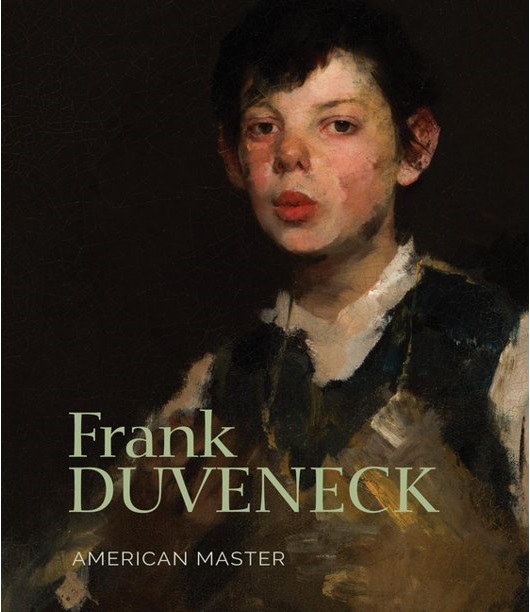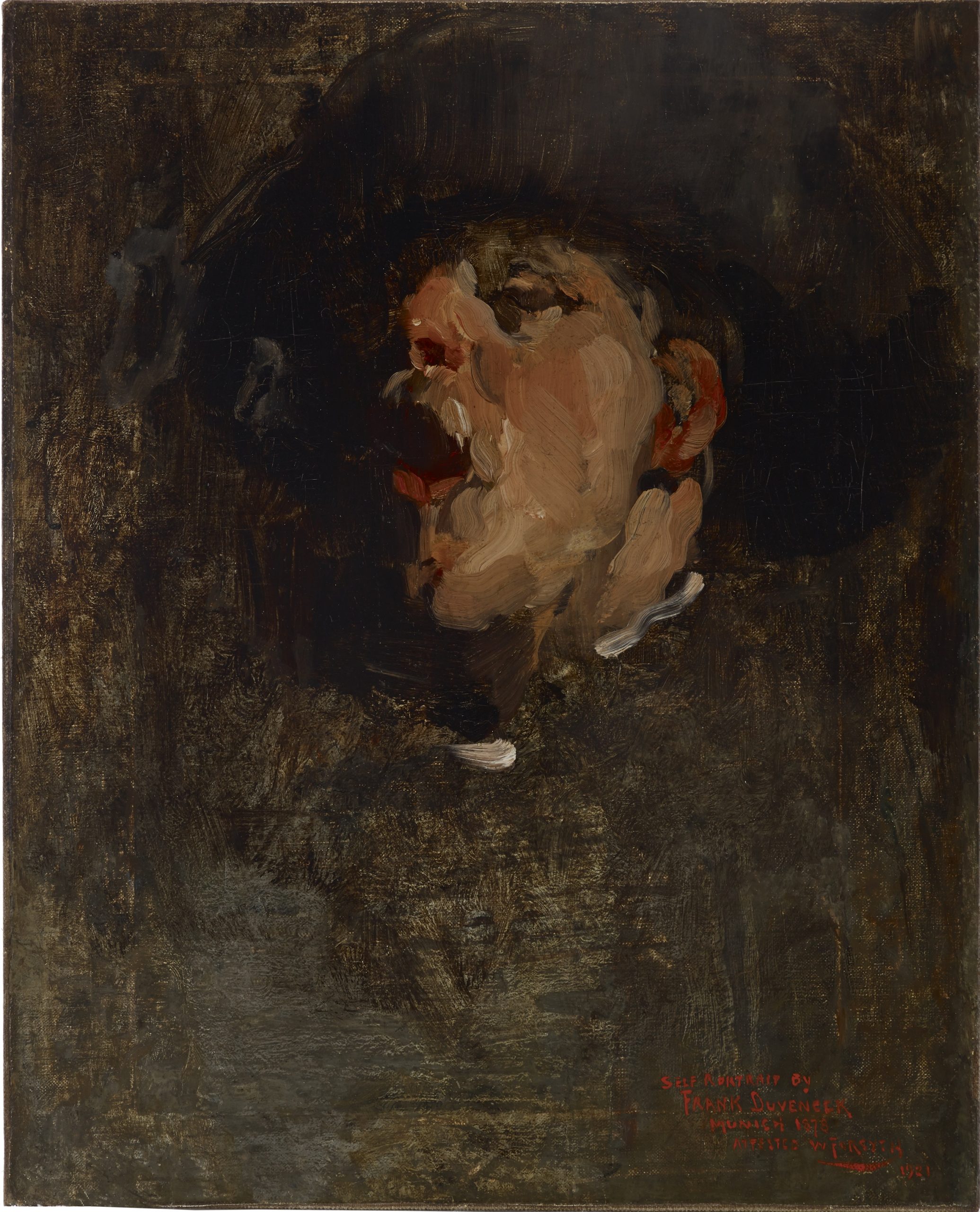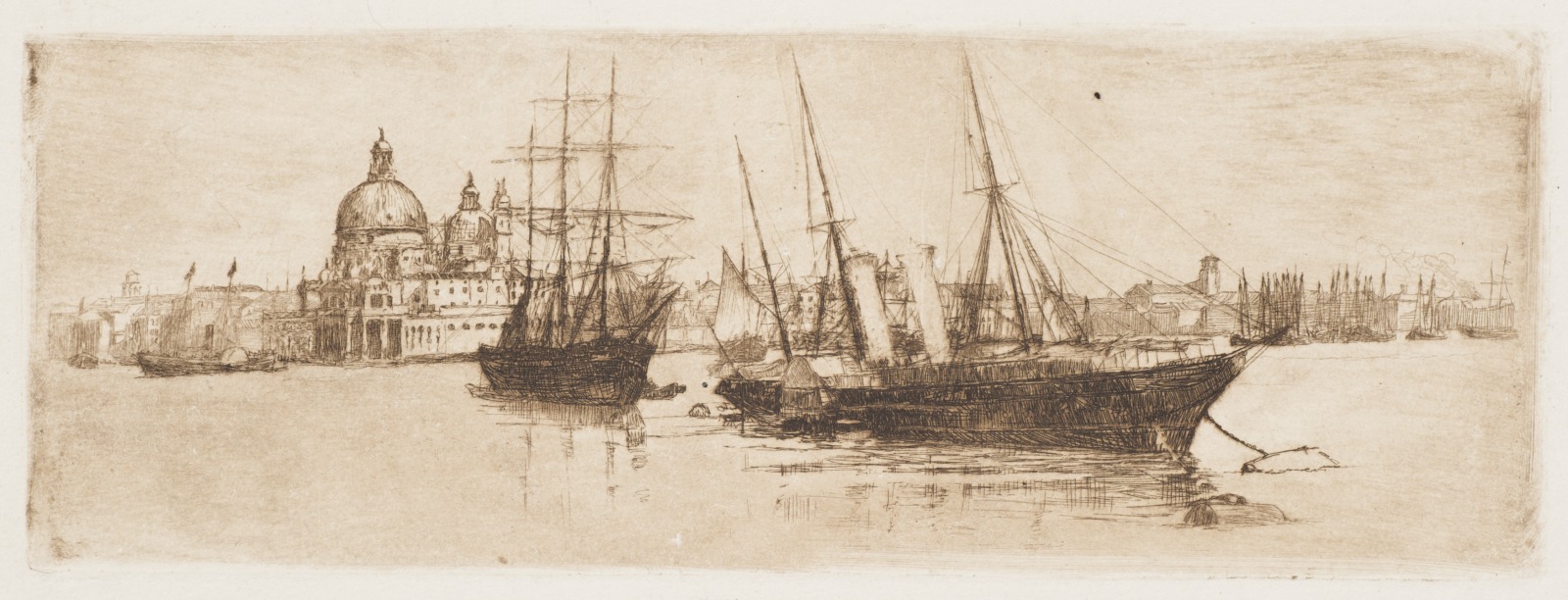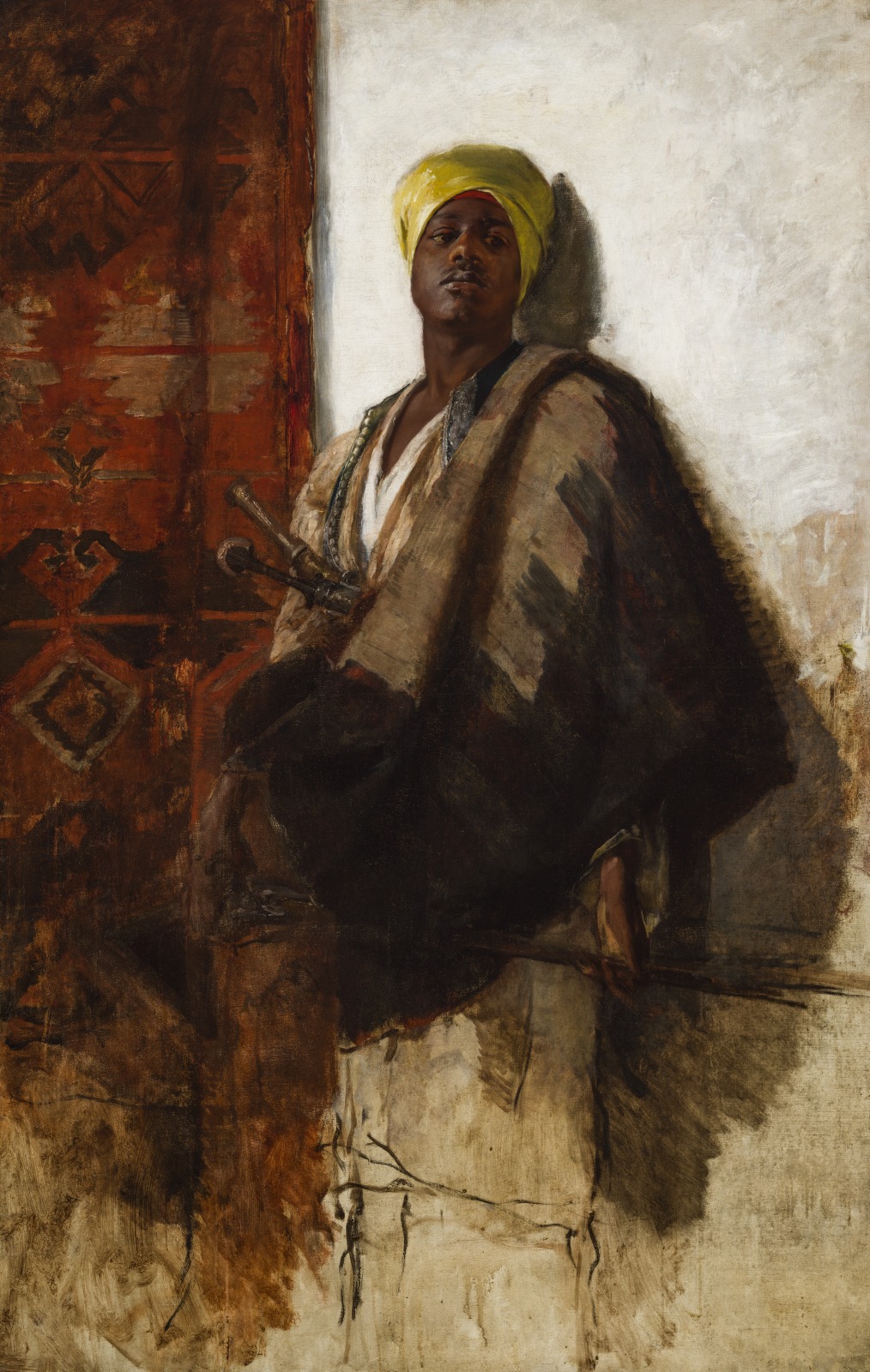Frank Duveneck: American Master
 Edited by Julie Aronson
Edited by Julie Aronson
With an introduction by Barbara Dayer Gallati and contributions by Julie Aronson, André Dombrowski, Sarah Burns, Colm Tóibín, Kristin L. Spangenberg, and Elizabeth A. Simmons
Exh. cat. London: D. Giles in association with Cincinnati Art Museum, 2020. 280 pp; 270 color illus. Softcover: sold through the Cincinnati Art Museum, $45.00 (ISBN: 9780931537035)
Exhibition schedule: Cincinnati Art Museum, December 18, 2020–March 28, 2021
Modern exhibition catalogues, especially when generated by museums, usually provide a larger context for their subjects and become standalone books integral to scholarship in the field. This is the case for the catalogue accompanying the exhibition Frank Duveneck: American Master, reviewed here without the benefit of visiting the show due to the pandemic. While it can be no substitute for seeing the 128 works gathered in Duveneck’s hometown, the hefty catalogue comes as close as possible to providing such an experience, and its six essays go beyond, to establish a new and broadened understanding of the artist and his identity.

The assembled paintings include many from the extensive holdings of work by Frank Duveneck (1848–1919) at the Cincinnati Art Museum (CAM), to which the artist gave his life’s work, beginning with The Whistling Boy in 1904 (fig. 1), as well as loans from other institutions and individuals.1 All of the exhibited works, along with numerous comparative figures, are illustrated in the catalogue. Its matte paper stock lends itself to the textural character of Duveneck’s paintings, of which important details are reproduced in full-page bleeds interspersed throughout the book, bringing the viewer into direct contact with the faces of Duveneck’s subjects as if in conversation with them. The reproductions capture Duveneck’s lush, robust brush handling, while they also reveal his sensitive side in smoother, more fastidious works, such as in a close-up of his half-sister Mollie (1888–90; Akron Art Museum), which reveals her lively intellect.
The exhibition curator and catalogue editor is Julie Aronson, the curator of American paintings, sculpture, and drawings at CAM. She is also one of the six contributors to the catalogue, which forms a densely interwoven story that expands our knowledge of Duveneck. The artist is mainly renowned as the ringleader of the Munich School, a group of rowdy American artists, active in the 1870s, who were popularly referred to as the “Duveneck Boys.” The artists challenged the prevailing conservative American art establishment, which bestowed favor on the studio-derived nationalistic wilderness scenes of the Hudson River School, by creating roughly executed, unidealized portraits and landscapes influenced by French and German realism and the dark tonalities in the art of old masters such as Frans Hals and Diego Velázquez. The other notable feature influencing Duveneck’s reputation is that the wife he adored, Elizabeth “Lizzie” Otis Lyman Boott (1846–1888)—who came from a world of wealth and privilege far different from his own humble beginnings as the son of German immigrants from Covington, Kentucky (across the river from Cincinnati)—died suddenly two years after they married, leaving the artist with their fifteen-month-old son.
Two in-depth references, both published in 1987, set a precedent for current Duveneck scholarship: Michael Quick’s catalogue for an exhibition at CAM and a monograph by Robert Neuhaus, who knew and advised Josephine Duveneck on her 1970 biography of her father-in-law.2 Both include perceptive and well-researched discussions of Duveneck’s art, mostly in relation to its European context. What distinguishes the present catalogue is that there is less emphasis on the relative merits of Duveneck’s work and more on seeing it, and the artist’s identity, from different angles while proposing directions for future scholarship. This agenda is laid out in the catalogue introduction by Barbara Dayer Gallati, curator emerita of American art at the Brooklyn Museum. While addressing scholarship on Duveneck subsequent to that of Quick and Neuhaus, Gallati suggests some of the avenues to be explored that can now be integrated with “primary sources unmined or unavailable” previously, and which provide an “imperative to ask new questions” (18).
In the first essay, Aronson considers Duveneck’s patrons in Boston and Cincinnati, revealing how his reputation was built by those who purchased his works, often as a result of connections between the older, established eastern city and Cincinnati, the Queen of the West. Aronson uncovers many new provenance details and highlights several independent activist women who acquired Duveneck’s work and supported his career. Noting that Duveneck might have followed another path if Lizzie had lived, Aronson acknowledges that it was her death that brought him back to Cincinnati, where he had a long, distinguished career at the city art academy. Among his patrons in the city was Herman Goepper, a malt-and-hop merchant the artist probably met through his stepfather, fellow “maltster” Squire Duveneck. The relationship of beer to the CAM perhaps goes back to Goepper, who became a museum trustee, and is retained today in a partnership with Cincinnati’s Listermann Brewing Company; a stout beer named for the exhibition has four labels bearing paintings by Duveneck. Purchasers can create mini Duveneck galleries at home while drinking a beer, brewed with dark rock candy that brings to mind Duveneck’s dark, frothy pigments.
Aronson’s essay and the catalogue in general attest to Duveneck’s significance in Cincinnati’s cultural identity, where his legendary generosity had a tremendous impact on the museum through his gifts, advice, and students, and with places and events in the city named for him. In fact, the catalogue itself is now part of the Duveneck legacy in the city.
In the second essay, André Dombrowski, associate professor of the History of Art at the University of Pennsylvania, excavates “the conceptual and practical stakes concerning both the techniques and critical languages of Duveneck’s art of the 1870s that have been buried over time” (52). Dombrowski challenges the artist’s reputation for masterful brushwork control—deriving from John Singer Sargent’s oft-repeated statement, cited first in 1915, that Duveneck was “the greatest talent of the brush of this generation.”3 Bringing to light earlier food-inflected descriptors for Duveneck’s art, such as “juicy” and “buttery” (as provided by his future wife, among others), Dombrowski uses incisive visual analysis to unpack how Duveneck departed in the 1870s from his Munich mentors: his teacher Wilhelm von Diez and the German realist Wilhelm Leibl.4 Contrasting works by Duveneck and Leibl, Dombrowski addresses the speed, fluidity, and darkness enveloping sitters that Duveneck achieved, enabling us with his close reading to visualize Duveneck grappling with forging a new active imagery, one “pronouncing its own material agency” that “flaunted rather than denied the organic constitution of painting” (53). Dombrowski therefore states that Duveneck heralded a “new quasi-sanctity of artistic processes and materials” (51). He next situates Duveneck’s work within the broader context of painterly realism in Germany, France, and the United States, where the style mutated as a dark alternative to French Impressionism, so that Duveneck might be considered a “dark Impressionist” before the French movement’s name was coined in 1874. Dombrowski concludes by comparing the denigrating reaction Duveneck’s works received in Munich in the 1870s with the laudatory one in the United States, where images such as his smoking boys—“savoring experience, sensation, and the pleasure of the phenomenal world”—seemed embodiments of social change and mobility, “fitting the American cultural and economic climate better than in Bavaria” (66).

The essay by Sarah Burns, the Ruth N. Halls Professor of Art History at Indiana University, also probes issues of reception. She points out how the subject matter and execution in works by Duveneck and other “new men” from Munich, including William Merritt Chase and Frank Currier, were described with masculine denotations and connotations by commentators such as Henry James, reinforcing that “inherently ugly, Munich-style realism was identified with culturally prescribed attributes—force, boldness, vigor, aggression, crudity” (71). She contends that ugliness alone could have been dismissed, but that the work troubled viewers because despite its foreign subject matter, it “hit too close to home” (73). Similar to descriptions of street waifs in Charles Loring Brace’s Dangerous Classes of New York (1872), “Munich beggars and ragamuffins called to mind the criminals and guttersnipes of New York and other big American cities—just at a time of extreme class conflict and social upheaval” (73–74). Burns makes an intriguing connection between such images and “the boogeyman of 1870s America,” namely the Paris Commune, the brief couple of months in 1871 when France was under a radical socialist government (76). She bolsters her argument with a comparison of street-boy images by Duveneck and Chase to the dreamy-faced, unthreatening boys in works by John George Brown that were widely disseminated in chromolithographs. In this context, she relates the “nominally Turkish” subject in Duveneck’s Turkish Page (1876; Pennsylvania Academy of the Fine Arts), portrayed in an Orientalized scene that he and Chase both painted in Chase’s studio in Munich, to Brace’s reference to impoverished street children as “the Arabs and gypsies of our day,” who “symbolically embodied both the mystery and the threat of the unknown hordes living in the city’s nether regions” (80). Burns’s view of the threat posed by Munich School paintings contradicts to some degree Dombrowski’s claim that Duveneck’s “fluidity signified so positively in an American context” (66). If, or how, both might be right could use some reconciling, and Burns might have supported her contention with more documentation. She concludes with a compelling association between the otherness of Duveneck’s street boys and how he may have perceived himself in relation to his wealthy and refined in-laws, finding in a roughly brushed 1878 self-portrait (fig. 2) a youth who “might be his own whistling boy, now fully grown yet stubbornly rejecting the decorum and restraint of adulthood” (82).
Burns’s essay leads into one by Colm Tóibín, a well-known author and Henry James specialist who is the Sidney B. Silverman Professor of the Humanities in the Department of English and Comparative Literature at Columbia University. Tóibín has addressed James’s treatment of Duveneck as a subject in his Jamesian novel The Master (2004) and in Henry James and American Painting (2017).5 Here, he details James’s friendship and correspondence with Lizzie Boott, one of his closest women friends, from the time he met her in Boston in 1865 through her studies with Duveneck, her courtship and marriage to the latter, and her death. He describes James’s use of the interplay between Lizzie, her music-composer father Francis, Duveneck, and the novelist Constance Woolson in varied forms in three of James’s best-known novels, Portrait of a Lady, Washington Square, and The Golden Bowl, noting that “Duveneck was the American artist James made most use of in his fiction” (95). In the essay, Tóibín observes that James’s many remarks on the difference between his world and Duveneck’s reflected “a strain of jealousy” on the novelist’s part at how easily Duveneck seemed to capture the affections of others. Ultimately, Tóibín suggests how art bridged the gap between the arch and erudite James and the “terribly earthy and unlicked” Duveneck (as described by James), as both “set about fixing the world in time and then transforming it,” creating worlds “more mysterious than the one from which they came” (101).

The essay by Kristin L. Spangenberg, CAM’s curator of prints, sets Duveneck’s etchings in the context of the American etching revival. Whereas Neuhaus cast aspersions on Duveneck’s etching skills, Spangenberg investigates his evolution in the medium.6 She explores the relationship between the contemporary Venetian etchings of James McNeill Whistler and Duveneck. In side-by-side comparisons, she reveals that Duveneck “favored overall completion, with firm and bold hatching describing structures, light and shadow, and action” in contrast with Whistler’s “vignettes of out-of-the-way canals and doorways, employing delicate lines and plate tone . . . in later impressions” (108). Some of the Duveneck Boys even took elements from both artists, as in Otto Bacher with Venice with Two Boats of 1880 (fig. 3), where the church of Santa Maria della Salute on the horizon seems derived from Whistler, while the P&O steamer in the foreground suggests Duveneck’s Laguna, Venice (1880; CAM). Spangenberg references the well-known incident that incensed Whistler when Duveneck’s etchings, displayed in London, were thought to be his under an assumed name, but she also tackles the etchings Duveneck created from 1883 to 1885, when he used more sophisticated techniques, such as correcting the mirror-imaging germane to the medium. Spangenberg ends by discussing Duveneck’s monotypes (never exhibited in his lifetime), which were “a natural extension of his brilliance as an alla prima painter” (115).

In the final essay, Elizabeth A. Simmons, CAM curatorial research assistant, provides an account of Duveneck’s drawings, which have not been previously explored comprehensively, along with other works on paper. Countering the notion that Duveneck was not a skilled draftsman, she discloses that Duveneck “utilized drawing throughout his career, as a tool for study, a key part of his working process, and an end in itself” (121). She describes Duveneck’s practice of taking sketchbooks to museums (one of the CAM sketchbooks is beautifully reproduced in a facsimile on the exhibition website), the social drawing that took place during evenings at the American Artists’ Club in Munich, Duveneck’s days spent painting and drawing in Venice, and the Duveneck Girls—the students of Duveneck’s “ladies’ class” in Florence. Simmons discusses Duveneck’s drawings for monuments, including that for his moving sculptural funerary effigy of his wife, created with the aid of Clement Barnhorn, and addresses his infamous pastel Siesta (c. 1900; CAM), depicting a nude woman atop rumpled bedcovers. The drawing hung in a local saloon until Prohibition, when the saloon’s owner gave it to the museum to taunt reformers, pronouncing: “That girl was too naked for my saloon but she was not too naked for high society” (132). Duveneck had long been rendering reclining female figures, but why he became fixated on large-scale female nudes at the height of Anthony Comstock’s campaign against such imagery is, in fact, a yet-unanswered question that Gallati poses in the catalogue introduction.7 On the basis of his virtuosic work in a variety of media, Simmons proposes a new interpretation of Duveneck as an “artist’s artist” rather than a “painter’s painter.”
Such a perspective expresses the catalogue’s vital scholarship-broadening project rather than a reductive approach to Duveneck. The use of “Master” in the exhibition title may strike a patriarchal note, but it fits Duveneck as an individualistic artist who followed his own path, had many followers, and weighed in on the work of others through his active role on exhibition juries. The masterful grip on him of his wife during their short years together, and Boott’s perspicacious insight into his art, are addressed by several authors, and a few of her works are discussed and reproduced in the catalogue. These glimpses pique our interest in her art. The catalogue is dense and thought-provoking, but even so, of necessity, some of the intriguing works in the exhibition are touched on only briefly or not all. Examples of this are Duveneck’s images of harem guards (fig. 4), in which he treated an exotic Salon-type subject with sensuous sensitivity. Consistent with Gallati’s proposals for further consideration of various facets of Duveneck’s work, the catalogue opens the door to explorations that can now build on the foundation of this ambitious and lasting contribution.
Cite this article: Lisa N. Peters, review of Frank Duveneck: American Master, ed. Julie Aronson, Panorama: Journal of the Association of Historians of American Art 7, no. 1 (Spring 2021), https://doi.org/10.24926/24716839.11839.
PDF: Peters, review of Frank Duveneck: American Master
Notes
- This gift consists of 120 oil paintings, two sculptures, seventy-nine prints, fifty-two drawings, and two sketchbooks. ↵
- Michael Quick, An American Painter Abroad: Frank Duveneck’s European Years, exh. cat. (Cincinnati: Cincinnati Art Museum, 1987); and Robert Neuhaus, Unsuspected Genius: The Art and Life of Frank Duveneck (San Francisco: Bedford, 1987). ↵
- First cited in J. Nilsen Laurvik, “Frank Duveneck,” in Catalogue De Luxe of the Department of Fine Arts, Panama-Pacific International Exposition, ed. John Ellingwood Donnell Trask and J. Nilsen Laurvik (San Francisco: Paul Elder, 1915), 1:29. ↵
- Leibl’s method in the 1870s was inspired by French realism, especially the work of Gustave Courbet, who visited Munich in 1869. ↵
- Colm Tóibín, The Master (New York: Scribner’s, 2004) and “Henry James: Shadow and Substance,” in Colm Tóibín, Marc Simpson, and Declan Kiely, Henry James and American Painting, exh. cat. (University Park: Pennsylvania State University Press, 2017). ↵
- Neuhaus, Unsuspected Genius, 100–113. ↵
- See Amy Werbel, Lust on Trial: Censorship and the Rise of American Obscenity in the Age of Anthony Comstock (New York: Columbia University Press, 2018). ↵
About the Author(s): Lisa N. Peters is an independent scholar

